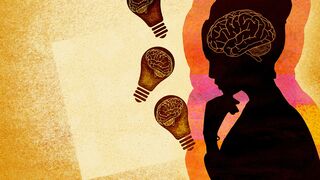Neuroscience
Understanding Interoception, the Sixth Sense
Inside the mystery of brain-body communication.
Posted August 24, 2022 Reviewed by Davia Sills
Key points
- The brain and body are deeply interconnected.
- The nervous system is always recording what is going on in the body.
- The brain processes bodily signals and makes meaning of incoming information.
- Interoception is an important component of emotional intelligence and social affective skills.

It is believed that in 30 seconds, the human brain goes through roughly the same amount of information as the Hubble Space Telescope processes in 30 years. Part of that data comes from the world around us; another part comes from our inner world—the body. Indeed, among the grandest feats of the brain’s spectacular repertoire is its ongoing conversation with the body.
Science has much yet to uncover about the mysteries of brain-body communication. A good place to start is interoception.
Interoception is “the process by which the nervous system senses, interprets, and integrates signals originating from within the body, providing a moment-by-moment mapping of the body’s internal landscape across conscious and unconscious levels” (Khalsa et al., 2018). This feedback loop of incoming and outgoing information between the brain and body has also been called our “sixth sense.” The brain’s ability to register, interpret, and integrate bodily signals is undoubtedly consequential for our well-being.
Psychologist Jennifer MacCormack investigates interoception, how it develops and ages, and how it interacts with bodily states like hunger to impact our emotions and behavior (such as feeling hangry). Here are MacCormack's thoughts on the remarkable brain-body alliance, from an interview I recently conducted with her.
The brain and body are deeply connected co-partners.
"The brain and body are deeply interconnected. I think of them as equal co-partners, or as one organism that is managing and processing different aspects of data from the environment (internal and external). If we were to eavesdrop on the conversation between the brain and body, it might sound like two very chatty co-partners driving a car together (Body: 'Oh, look, this and that are changing!' Brain: 'All good here. Maybe then turn this up and maintain that.'). Since the brain and body are allies, both are responsible for keeping the 'car' (us) moving.
"We often think in terms of dualities: emotion versus cognition, body versus mind, and peripheral versus central nervous system. While these divisions are useful in daily conversation and philosophical debates, we should be careful not to overlook how deeply intertwined these processes may actually be."
The body is foundational for the self.
"Many researchers have proposed that bodily awareness (the body’s position in space, i.e., proprioception, or internal bodily sensations like your heart beating, i.e., interoception) is an early, foundational part of our sense of self. The body constantly sends afferent signals via the spinal cord up to the brain, communicating about its current resources and needs, which the brain then uses to guide how we feel, think, and react. Cognitive science has not always appreciated this bottom-up, body-to-mind path. We’ve long focused on the brain as the central driver of the 'self.'
"But each body has unique structural and functional variations shaped by epigenetics, environment, and lifestyle. This embodied variation helps determine more stable differences in the self (e.g., temperament) as well as brief within-person differences (e.g., being more easily upset when tired versus rested). Several experiments also reveal that afferent bodily signals can shape our emotions, social perceptions, and decisions. For example, people who are more interoceptive appear to make better intuitive gut decisions, such as placing bets or stock trading."

The nervous system is always recording what is going on in the body.
"By necessity, the brain must constantly monitor and manage what is happening in the body (known as allostasis). The brain relies on afferent bodily signals to ensure that there are enough physiological resources (e.g., glucose, oxygen) for behavior at any given moment. For example, during a perceived threat, the brain tells the heart and lungs to pump more blood to the arms and legs to help fuel the muscles for action (e.g., fight or flight). To do that, the brain also needs to know the body’s available and reserved metabolic energy and any other relevant energy constraints (e.g., if the body is fighting off an infection). This vigilance helps the brain better coordinate an efficient response to whatever life events or challenges we encounter."
What bodily signals become conscious depends on many factors.
"How much and which bodily signals become conscious is a complex question. Of course, it would be information overload if we were consciously aware of every little fluctuation in our body’s homeostatic parameters. Instead, conscious bodily sensations likely depend on whether and how much of that bodily signal the brain predicts will motivate the needed behavior. If your blood sugar dips, it’s important to make those metabolic signals more conscious as unpleasant hunger sensations, helping motivate you to eat. Conversely, if you’re under a prolonged stressor, minimizing conscious bodily sensations could help you better cope.
"However, there are many other interoceptive differences that help determine when and how much some people experience their bodily signals more than other people. For instance, some people preferentially focus on interoceptive cues in how they describe and relate to the world. Some individuals are also more accurate or sensitive to their bodies. We aren’t sure yet why people have these interoceptive differences. This is an area of active research. But it’s likely a combination of factors—such as how we’re raised, the kinds of life experiences we have, and differences in nervous system functioning and development."
By processing bodily signals, the brain makes meaning of incoming information.
"Another important question is how the brain makes meaning of bodily signals. As “'raw' bodily signals enter the spinal column, some afferent nerves connect to the same spinal neurons. This means that sometimes signals get mixed together.
"A good example of this is referred pain during a heart attack, when people can experience arm rather than chest pain because cardiac and arm nerves connect at the same spinal location. The brain then must solve the puzzle of incoming bodily information by inferring the signal’s source (heart or arm?) and making coherent meaning out of it. It does this in many ways—by monitoring relevant hormone levels that cross the blood-brain barrier, by using temporal information (how frequent is the bodily signal? what time of day is it?), and likely also by considering the current situation we’re in. The brain processes this bodily meaning below the threshold of conscious awareness—we simply experience the product, such as feeling our heart racing, being tired, tense, etc."
We can misread the signals from our bodies.
"The brain, however, is not a perfect predictor of bodily meaning. Referred pain is one example. Other times, whether due to signal intensity or ambiguity, due to environmental distractions, etc., our brains might attribute bodily signals differently. Furthermore, because sometimes bodily signals become conscious sensations, and other times they don’t, this leads us to make different mental attributions about why we feel the way we do, based on where we’re focusing awareness. For instance, my collaborators and I have suggested that feeling 'hangry' occurs when we aren’t aware that hunger is influencing our feelings.
"Another way that we can apply meaning to bodily sensations is through our interoceptive beliefs. Interoceptive beliefs, such as how valuable or dangerous people believe their bodily signals are, can matter for experiences like stress. For example, individuals with anxiety sensitivity are more likely to 'catastrophize' and become distressed by increased heartbeats during a stressor compared to individuals without anxiety sensitivity. We likely develop our interoceptive beliefs based on our upbringing and life experiences (e.g., a trauma), but it’s also possible that factors such as how intensely our bodies tend to react could, over time, influence these beliefs."
Interoception has a place under the umbrella of emotional intelligence.
"Interoception is central to many emotional processes. Both interoceptive skills (e.g., being more sensitive to or aware of specific bodily sensations) and interoceptive knowledge (e.g., meta-cognitive awareness, beliefs) likely matter. My collaborators and I have found that higher interoceptive accuracy also helps people more accurately identify when their feelings and behaviors are rooted in internal bodily changes versus social events.
"In other research, I’ve found that some mothers characterize their emotions with greater interoceptive nuance. This more nuanced interoceptive understanding in turn predicted children’s better social and emotion regulation skills. Ongoing studies like these in interoceptive science help affirm that interoception is an important aspect of emotional intelligence and social affective skills."
Positive interceptive beliefs may contribute to well-being.
"Positive interoceptive beliefs include beliefs that bodily signals are a valuable source of insight and that bodily signals, even unpleasant ones, are not necessarily distressing or detrimental. Many studies suggest that this comfortable, trusting mindset towards the body may have positive effects for well-being. For instance, I’ve found that people with more positive interoceptive beliefs had better outcomes during a social stressor than people with negative or neutral interoceptive beliefs. While being able to accurately identify your bodily signals is important, what might matter more for well-being is how you then interpret and react to your identified sensations."
For optimal health and well-being, aim for an interoceptive middle ground.
"Most of us don’t fully appreciate how the body matters until we experience illness, disease, or interoceptive dysfunction. But it is important to find a middle ground. On the one hand, people who over-focus on the body may be more likely to “over-detect” or overinterpret their bodily signals—such as in cases of hypochondriasis or anxiety. But it’s also problematic to go too far the other way and actively ignore, suppress, or discount bodily signals. For example, tracking unusual bodily changes (e.g., frequent blood sugar crashes) could help you identify when you need to go to the doctor. A middle ground—not too much and not too little interoception—is likely optimal for physical and psychological health."
Jennifer MacCormack, Ph.D., is an assistant professor of psychology at the University of Virginia and the Principal Investigator of the Virginia Affect and Interoception Laboratory.
References
MacCormack, J. K., & Lindquist, K. A. (2019). Feeling hangry? When hunger is conceptualized as emotion. Emotion, 19(2), 301.
Khalsa, S. S., Adolphs, R., Cameron, O. G., Critchley, H. D., Davenport, P. W., Feinstein, J. S., ... & Zucker, N. (2018). Interoception and mental health: a roadmap. Biological Psychiatry: Cognitive Neuroscience and Neuroimaging, 3(6), 501-513.
Feldman, M. J., MacCormack, J. K., Bonar, A. S., & Lindquist, K. A. (under review). Interoceptive ability moderates the effect of physiological reactivity on social judgment. Preprint.
MacCormack, J. K., Bonar, A. S., & Lindquist, K. A. (under review). Interoceptive beliefs moderate the link between physiological and emotional arousal during acute stress. Preprint.
MacCormack, J. K., Castro, V. L., Halberstadt, A. G., & Rogers, M. L. (2020). Maternal interoceptive knowledge predicts children’s emotion regulation and social skills in middle childhood. Social Development, 29, 578-599.




